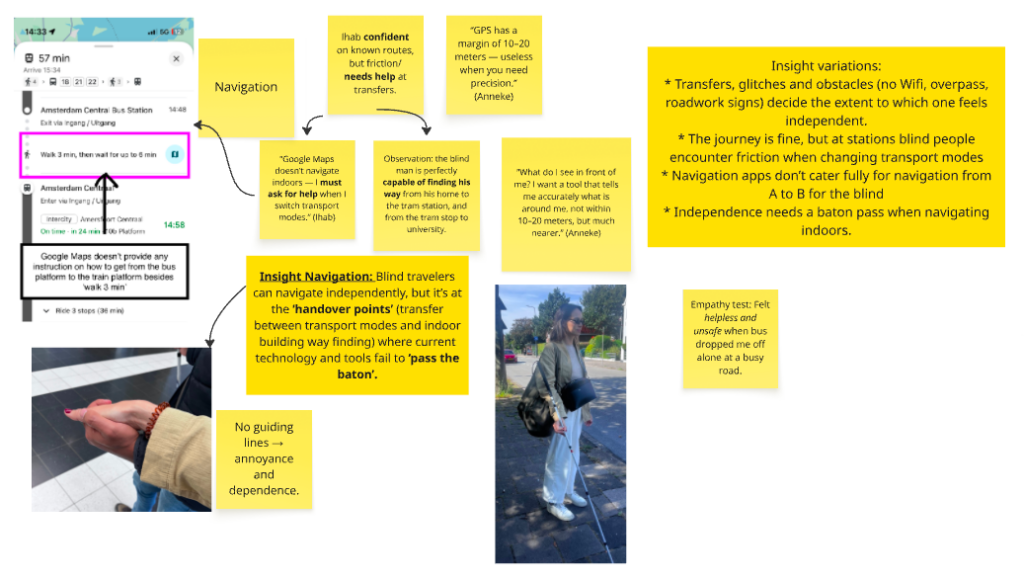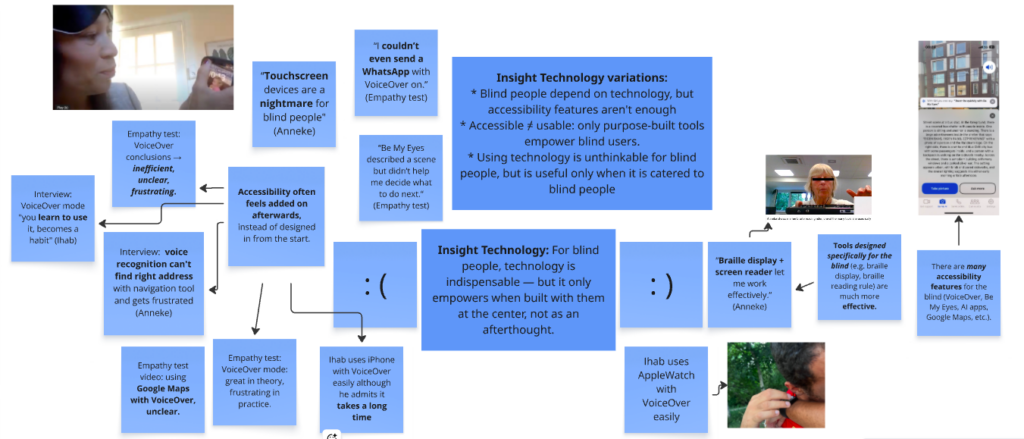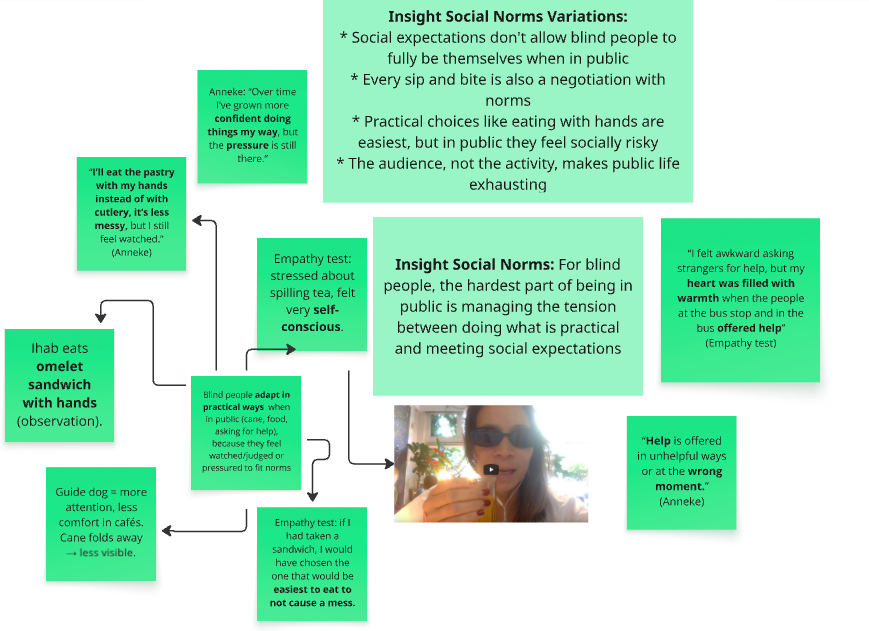IDEO U’s Insights for Innovation – Foundations of Design Thinking course consists of 2 courses: ‘Insights for Innovation’ and ‘From Ideas to Action’. In this blog post I share the 4 assignments belonging to the first course ‘Insights for Innvation’.
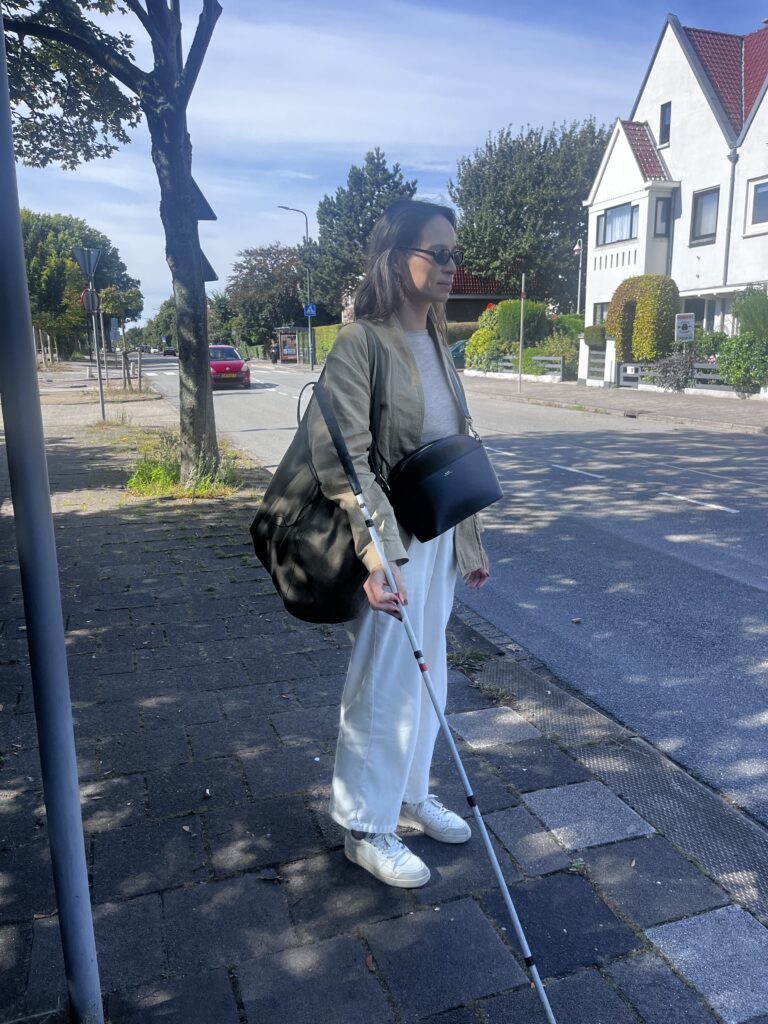
Introduction Assignment
Why did you choose it?
One of the valuable aspects of this course is the chance to immerse ourselves in a topic that is relatively unfamiliar. I believe that the further the target group is from my own lived experience, the more surprising and insightful the discoveries can be.
Recently, I met a blind runner at a social event in Amsterdam. Listening to him share how he navigates university and daily life was inspiring. His courage, audacity and determination left a strong impression on me. It also reminded me how rarely I stop to reflect and feel grateful for my own eyesight, despite wearing glasses and often wishing for “perfect” vision. This encounter sparked my curiosity, and I am excited to learn more about the experiences, challenges, and strengths of people who are blind.
What existing assumptions do you have about this challenge?
I recognize that my perspective is shaped by limited personal exposure, so my assumptions may well be inaccurate or incomplete. At this point, I assume that people who are blind:
- May face challenges in accessing entertainment, such as reading, visiting museums, going to the cinema, unless these are adapted.
- Could experience difficulties with independent navigation, which might make going out less straightforward.
- Might encounter barriers in using smartphones and other digital devices without assistive technology.
- May face more difficulty encountering a romantic partner than people with vision.
- Might face obstacles in staying physically active, depending on the availability of accessible sports or safe environments.
Lesson 1 Observing Assignment
Share your plan from Step 1
Who could I view?
Blind people walking around with a guiding stick or guiding dog.
Where to go online?
- Reddit thread(s) like https://www.reddit.com/r/Blind/
- Maybe TikTok and Youtube “day in the life” videos
Where to go offline?
- I will reach out to the Running Blind Amsterdam organisation, as well as the Royal Fund for Guided Dogs (Koninklijk Nederlands Geleidehonden Fonds). I will also reach out to various student organisations who represent students with a limitation. I will reach out to the blind runner, Ihab, that I met at the social night of the running club.
What things to watch for?
- How people that are legally blind…
- go about getting from A to B
- organise their home
- interact with their smartphone (surfing the internet, replying to Whatsapp messages, etc)
Summarize what you did and saw for Step 2 (Observe Others)
Offline
I got back to the blind runner, Ihab, who I met during the social running event and explained how he had inspired me to focus on the legally blind for my current course. He was excited to hear this and happy to welcome me in his home to show me around. He offered to then travel together to university by tram so that I could also see how he used public transport to navigate. Furthermore, by coincidence I briefly observed a blind woman in public transport waiting at the platform.
Online
I browsed through TikTok’s BlindTok trend, and read various threads on Reddit’s /blind subreddit.
Observations Summary
Objects
- Ihab uses a guiding stick when navigating outside. He tells me that there’s a waiting list of two years for guiding dogs. He doesn’t see the real benefit of having a dog over using a stick.
- The blind woman on the platform also holds a stick. Furthermore, she is talking to a hardware tool without a screen with which she seems to be navigating. She tells the hardware a street name and number, and the machine gets the number wrong at least 3 times. The woman gets frustrated but doesn’t stop until the machine confirms the correct number.
Environments
- When travelling to his university, Ihab knows the way to the tram by heart. Once we are outside the house, Ihab holds my hand and uses his stick to detect obstacles. When we enter the tram, he has some difficulty scanning his public transport card. Inside the tram, it is very crowded and he holds himself by grabbing a hand holder and holding my arm. He listens carefully to the voiceover of the stops to get out at the right stop. When waiting on the tram to arrive, he tells me this tram stop doesn’t have guiding lines, which annoys him. When we get out at our final stop, he mentions how this specific stop does have guiding lines, points at them for me, and mentions that it’s very helpful.
- When I observe the blind woman on the platform, she leans towards the top of the staircase while she talks to the hardware device.

Adaptations
- Different cooking setup
- In the kitchen I see that Ihab uses a cooking stove, an electrical one that gets hot rather than using a stove with gas or induction. A toasting machine stands on top of the stove, making it currently impossible to cook.
- Different use of smartphone
- When I watch Ihab use his smartphone, he talks to his phone rather than viewing the screen. He has iPhone’s VoiceOver mode turned on. He holds his smartphone close to his face and rapidly taps the screen to navigate to the correct app or button. The phone’s voice dictates the buttons he is touching when he is on a website. When on Whatsapp, he holds the voice recorder to dictate what he wants to type. Going online watching BlindTok I see how AI helps the legally blind using a smartphone to explain what is shown in a video on a smartphone screen, or what is in the person’s near vicinity when pointing the smartphone in a certain direction. Furthermore, I see that Ihab wears an Apple Watch. I don’t see him use the watch.
- Different way of consuming lunch
- To thank Ihab for his time, we go for lunch at a local restaurant. Ihab prefers to use his hands rather than cutlery to eat his omelet sandwich. Considering the sandwich is not a bun, it is less straightforward to want to use hands rather than cutlery.
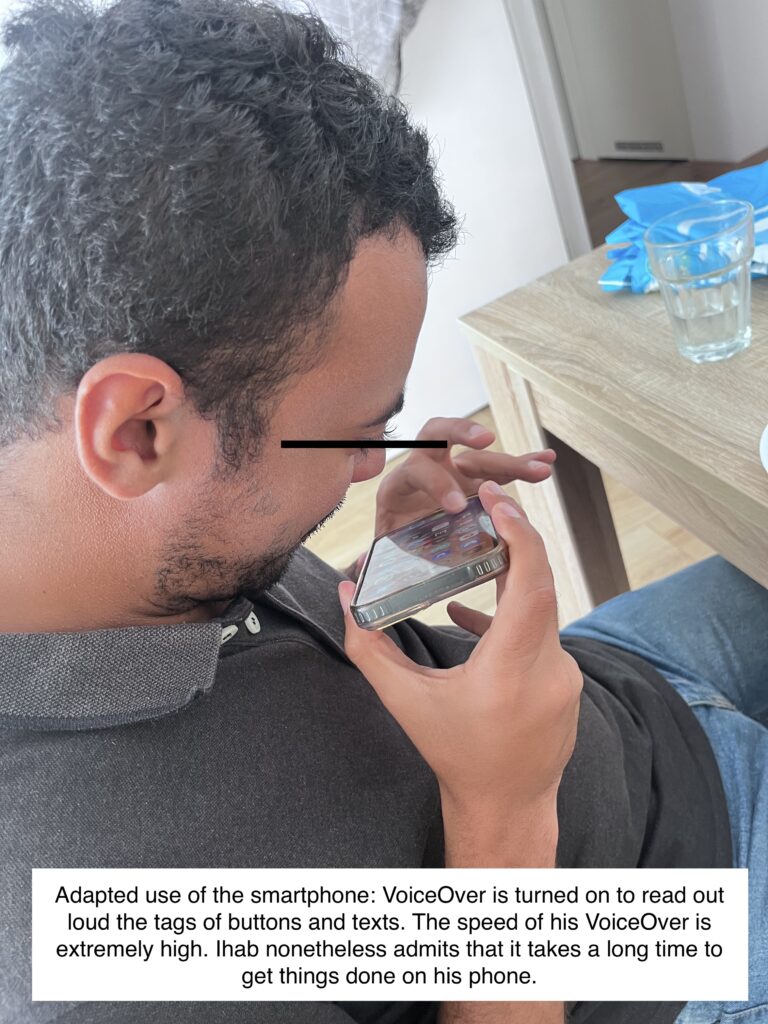
Patterns
- The pattern I see is structure and organisation: his home is very neat and organised. For example, all his clothing is organised per tray, and he knows exactly which tray is used for which clothing category. In the kitchen, the cabinets all have a specific purpose, as well as the drawers for cutlery. His bathroom and bedroom are decorated simply.
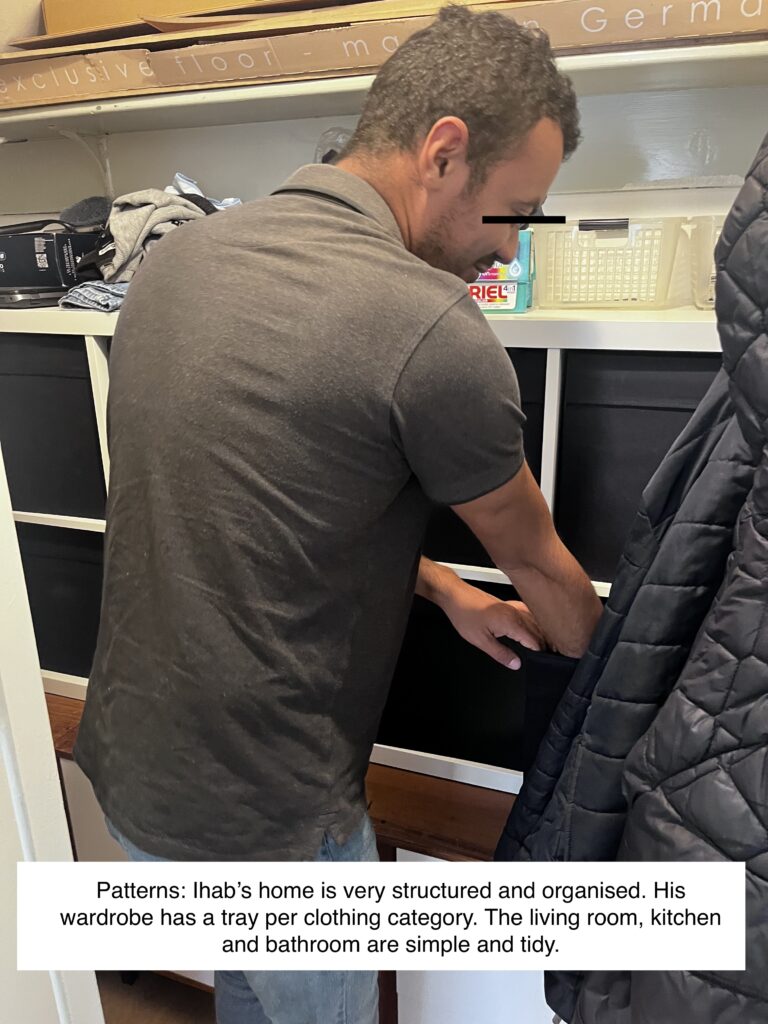
3 observations that sparked my curiosity
- The challenge of navigating from location A to B
- What sparks my curiosity is the tension between confidence and friction in navigating. Ihab moves with ease when he knows the route, yet runs into small struggles like scanning his card or missing guiding lines. The woman on the platform relies on a device that repeatedly misunderstands her, but she persists until it works.
→ I’d be curious: when does technology enable independence, and when does it add new layers of frustration while navigating?
- What sparks my curiosity is the tension between confidence and friction in navigating. Ihab moves with ease when he knows the route, yet runs into small struggles like scanning his card or missing guiding lines. The woman on the platform relies on a device that repeatedly misunderstands her, but she persists until it works.
- Technology adoption and preferences
- Ihab seems very adept with his iPhone using VoiceOver, and he also owns an Apple Watch but doesn’t use it visibly. The blind woman uses the hardware device but it frustrated her. The use of technology seems to play a big role in the lives of blind people.
→ I’d want to know: what (features of) devices are actually useful for blind users? Is there untapped potential in wearables or AI that could make daily navigation, time management, or online life smoother?
- Ihab seems very adept with his iPhone using VoiceOver, and he also owns an Apple Watch but doesn’t use it visibly. The blind woman uses the hardware device but it frustrated her. The use of technology seems to play a big role in the lives of blind people.
- Social norms and adaptations in public spaces
- Ihab ate his sandwich with his hands rather than cutlery. On public transport he listens closely to audio cues, and he cares deeply about guiding lines on tram stops.
→ I’m curious: how much does social context (restaurants, crowded trams, university) affect the comfort level of blind people in using adaptations that work best for them, even if they differ from the norm?
- Ihab ate his sandwich with his hands rather than cutlery. On public transport he listens closely to audio cues, and he cares deeply about guiding lines on tram stops.
Reflections on this assignment
I resubmitted my Observations assignment because the teaching lead remarked that my assignment was in fact an interview with a couple of show-me moments. It was a great learning moment as I realised I initially hadn’t taken the viewpoint of the observer. Through resubmitting my assignment, I’ve learned to be more aware next time I observe, and really listen with my eyes. For resubmitting this assignment, I thought back on the time spent with Ihab where I noticed things he didn’t specifically mention. I’m very happy to have gone through this exercise twice as the objective of observing is now much clearer.
Lesson 2 Interviewing Assignment
Share your eight to ten interview questions for Step 1
- The challenge of navigating from location A to B
- I’d be curious: when does technology enable independence, and when does it add new layers of frustration while navigating?
- We met each other on the platform and you were talking to a device. Could you tell me more about the device you were using?
- Which aids or technologies do you personally prefer to use when navigating?
- I’d be curious: when does technology enable independence, and when does it add new layers of frustration while navigating?
- Technology adoption and preferences
- I’d want to know: what (features of) devices are actually useful for blind users? Is there untapped potential in wearables or tech/AI that could make daily navigation, time management, or online life smoother?
- If I were to take away your access to technology such as smartphones, digital watches, or a laptop, what are the 3 things you would miss the most?
- To what extent do artificial intelligence tools play a role in your life?
- If you could design one new technological feature to make your daily life easier, in what area would it be, and what would it do?
- Are there devices or apps you have tried that caused more frustration than help?
- When do you mainly rely on your own memory or routines, and when on technology?
- I’d want to know: what (features of) devices are actually useful for blind users? Is there untapped potential in wearables or tech/AI that could make daily navigation, time management, or online life smoother?
- Social norms and adaptations in public spaces
- I’m curious: how much does social context affect the comfort level of blind people in using adaptations that work best for them, even if they differ from the norm?
- The blind man that I observed used his hands to eat his sandwich. In public situations, what kinds of pressures do you experience to adapt in ways that aren’t actually convenient for you?
- How do you decide when to adapt to social norms (for example, using cutlery in a restaurant) and when to choose what is most practical for you?
- I’m curious: how much does social context affect the comfort level of blind people in using adaptations that work best for them, even if they differ from the norm?
Summarize what you did for Step 2
I’ve interviewed both Anneke, the blind woman I saw in public transport, and Ihab, the blind man I observed for my first assignment. Below are my 2 highlights as well as an explanation of why these stick out.
Highlight 1: The challenge of navigating from A to B and the role of technology
Anneke and Ihab both mention navigation as the biggest opportunity for technological improvement, as it causes the greatest frustration. Anneke described how she uses different tools depending on the situation: a cane for constant ground feedback, the NS Reisplanner app for reliable travel planning, and her voice memo (Google Calendar for non-blind people) and her navigation hardware device (for navigation).
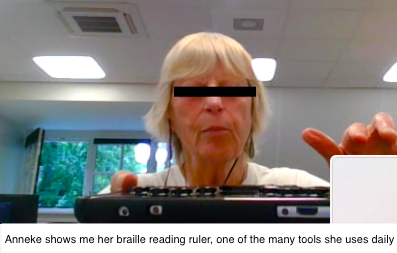
Ihab uses his AppleWatch in daily life as one of his main go-to tools.
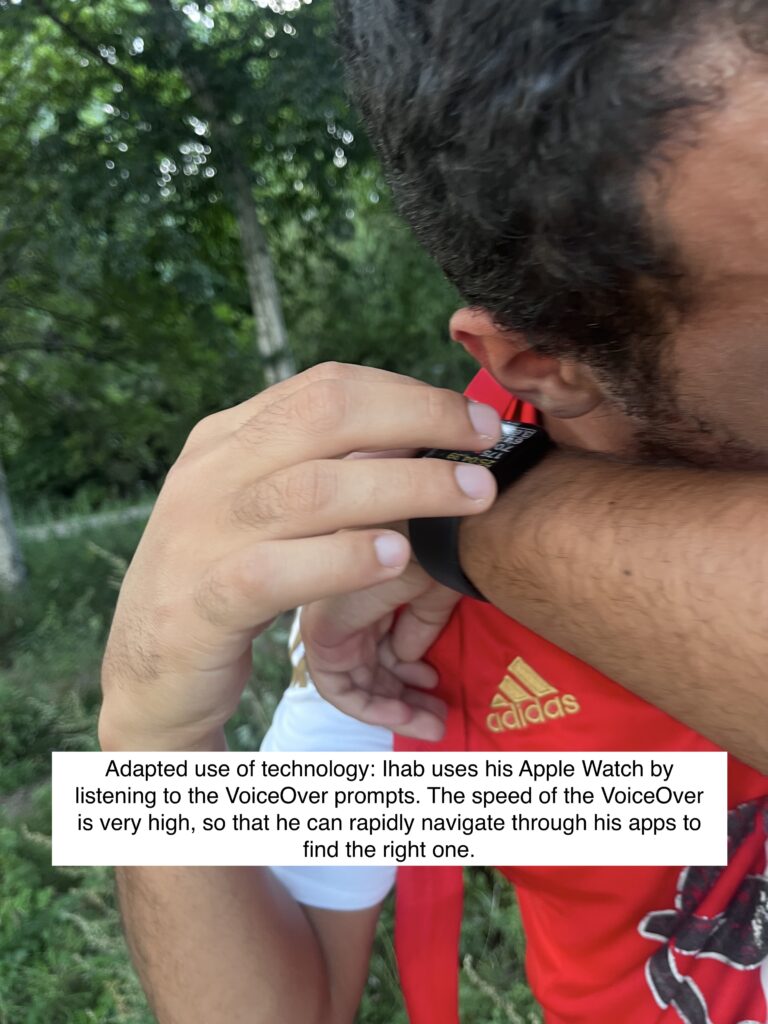
Annke also noted frustrations: Google Maps is less accessible than the NS Reisplanner app, GPS lacks precision (eg outdoors near bridges), and noisy environments or complex indoor spaces like stations remain hard to navigate.
“What do I see in front of me? I want a tool that tells me accurately what is around me, not within 10-20 meters, but much nearer.” – Anneke & Ihab
She sees promise in AI for smarter navigation (e.g., describing surroundings, detecting obstacles at head height), as current solutions are fragmented and inconsistent.
“I’m waiting for a smart guiding stick that has AI built-in, with object detection and Google Maps navigation. In this way, I wouldn’t hit my head. It’s in development.” – Anneke
Ihab corroborated this by mentioning that if he switches travel medium (from bus to tram or to train), he always needs to ask for help as Google Maps (his preferred app), doesn’t navigate within stations.
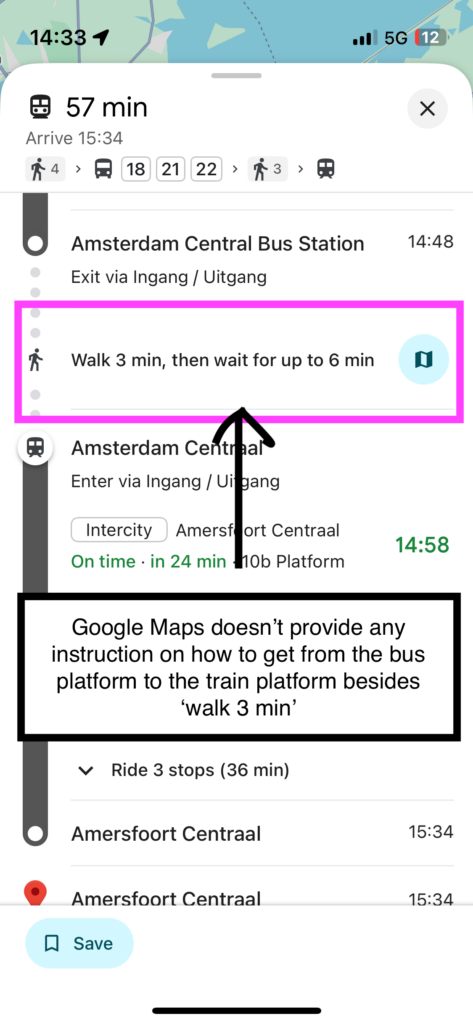
He finds this annoying as it limits him in his independence. He mentioned that an AI robot dog is in development that would help him navigate within buildings, but its release is postponed, which he is sad about because he thinks it would improve his quality of life a lot.
- Why this stood out: it reveals how central technology is in the lives of blind people, and how plentiful the opportunities are to improve technology within the domain of navigation. Specifically, technology needs to be more precise for blind people to navigate indoors, allowing them to be more independent. This is an unmet need.
Highlight 2: Social norms and adaptations in public spaces
“One of the downsides of having a guiding dog is to walk into a cafe and draw even more attention. At least I can fold a guiding stick” – Anneke
Anneke shared how in meetings or restaurants she sometimes eats with her hands rather than with cutlery, because it is simpler and less messy for her. Other times, she might refuse a pastry from partners she works with if she believes it results in messy situations. Over time she has grown more confident doing things “her way,” but she still notices how social expectations create subtle pressure. She also expressed frustration about how people offer help at moments that she doesn’t “communicate” needing help. Ihab using his hands to eat his sandwich rather than cutlery during the Observation lunch confirmed how other blind people experience this social pressure.
- Why this stood out: It highlights that the challenge is not just physical or technological, but also social. Blind people need environments and interactions that allow them to use practical adaptations without stigma or unnecessary pressure. This is a latent need.
Reflections
Thanks to the interview, I have gained more insight into the lives of blind people. Specifically, I hadn’t realised how dependent blind people are on technology to simply live their lives. Navigation is a highly interesting domain to explore further, as both Anneke and Ihab mentioned this as the domain in which they experience most frustration. This made me realise how much untapped potential there might be in using AI/tech to help the blind. Besides, I hadn’t thought of the social aspect of the challenges the blind face. Walking around with a guiding stick or dog draws attention, and whatever solution we might at some point think of, shouldn’t add to the awkwardness blind people face daily.
Furthermore, this assignment made me realise how resilient blind people are. Both Ihab and Anneke show grit, and their view on living life is inspirational for the non-blind. Last, it made me realise how many things I take for granted being able to see: using a smartphone or laptop navigating apps and websites, travelling or looking up my directions, easily using Google Calendar for personal reminders, being able to do my work without hindrance of using my mouse, scrolling websites and using any other forms of technology such as Slack, Teams etc. I truly feel blessed with my eyes and I won’t be jealous at people with perfect eyesight anymore (needing glasses myself). This assignment has made me more humble and empathetic towards people with a disability.
Lesson 3 Immersive Empathy Experience
What did you want to learn?
- Navigating from A to B with and without technology
- What’s it feel like to travel from A to B and rely on other people to know where to go?
- What’s it feel like to depend on VoiceOver mode rather than eyesight to use a smartphone while navigating?
- Social
- What’s it feel like to be in a public space and feel like a burden?
- What’s it feel like to be in a situation that asks you to eat while you can’t make sure that it will become a messy situation?
What empathy experiments can you run?
Navigating from A to B
- Blindfolded commute challenge
- I could travel a familiar route (e.g. tram or bus to Amsterdam Centraal) blindfolded with only a cane.
- Station indoor navigation simulation
- I could go to a large station (e.g. Utrecht Centraal) and try to navigate key transfers (bus → train, train → metro) without sight, relying only on audio cues and tactile lines.
- Visit MuZIEeum museum
- I could visit MuZIEum museum in Nijmegen, a museum that gives people with eyesight an idea what it is to be blind. They organise guided blindfolded walks. I could participate in one of those.
Technology adoption & preferences
- Voice-only smartphone day
- I could turn on VoiceOver on iPhone and commit to using my phone only via voice feedback for messages, calendar, navigation, internet browsing.
- Braille display trial
- I could visit a rehabilitation or accessibility center (e.g. Bartiméus or Visio) and try working with a braille display connected to a laptop.
- AI assistant experiment
- I could use AI apps like Be My Eyes (with AI beta), Seeing AI, or Aira in a daily routines (finding items, reading labels, navigating indoors).
Social norms & adaptations in public spaces
- Dining in the dark
- I could go to Ctaste in Amsterdam or a similar “dark dining” restaurant.
- Work meeting blindfolded
- I could join a work or study meeting with a blindfold, relying only on audio cues to follow who speaks.
- Public help experiment
- I could walk blindfolded in a crowded public space and see when people offer help, how they do it, and how it makes me feel.
Integrative / reflection
- “Day without sight” diary
- I could spend a full day at home and outside blindfolded, journaling each small friction (cooking, dressing, finding keys, crossing streets).
What was your plan?
My plan was to approach experiencing being blind from different angles. I chose the following exercises:
Immersive Empathy Plan: Experiencing being Blind
1. Technology (≈ 1 hr)
- Exercise: Turn on VoiceOver on iPhone.
- Send a message on Whatsapp
- Use GoogleMaps to plan my itinerary from A to B
2. Navigation (≈ 30 min)
- Exercise 1: Travel blindfolded with a cane from a bus stop to elsewhere.
- Exercise 2: Download and test Be My Eyes (AI mode) while in public transport.
3. Social Norms (≈ 30 min)
- Exercise 1: Have lunch or coffee in a café. I blindfold myself and try eating a sandwich / drinking a coffee.
What did I consider before executing?
- I wanted to take a broad perspective to really experience immersive empathy
- I took into account my safety
- When I was brainstorming about these immersive empathy exercises I became self-conscious about how I would come across acting blind outside of my home. I was really dreading the exercises that I had planned to do in public. But I got over myself knowing that this is what blind people face every day.
What are one to three highlights from your empathy experience (Step 4)?
I’m so glad to have done this exercise, as it was really the first time that I practiced immersive empathy with a target group I knew nothing about.
A. Using technology: technology can be empowering, if usability in practice helps blind people execute their tasks
I started with a couple of exercises using VoiceOver on my iPhone. The idea of VoiceOver mode is fantastic: helping out those who have trouble reading the screen. The whole experience turned out terrible. Clearly, I’m not used to VoiceOver mode and I can imagine becoming better at it with time. For this short period, it was evident that one needs a tremendous amount of patience to navigate a touchscreen with VoiceOver mode turned on. I got really frustrated, and wasn’t able to reach my goals of sending a Whatsapp message, or finding the itinerary on Google Maps.
I also tried the app Be My Eyes AI mode, to take a picture in public transport and describe what I see, so that I could decide on my next step. The description of the photo was very detailed, and with the information I know that I am near the bus stop. I don’t know if this description provides enough information to take action, but that might not be the goal of Be My Eyes. If it’s really just to describe a scene of what’s in front of you, it does a good job. In this way, I can see how advanced technology like AI is empowering when it meets the goal you’re trying to achieve (simply describing what’s near).
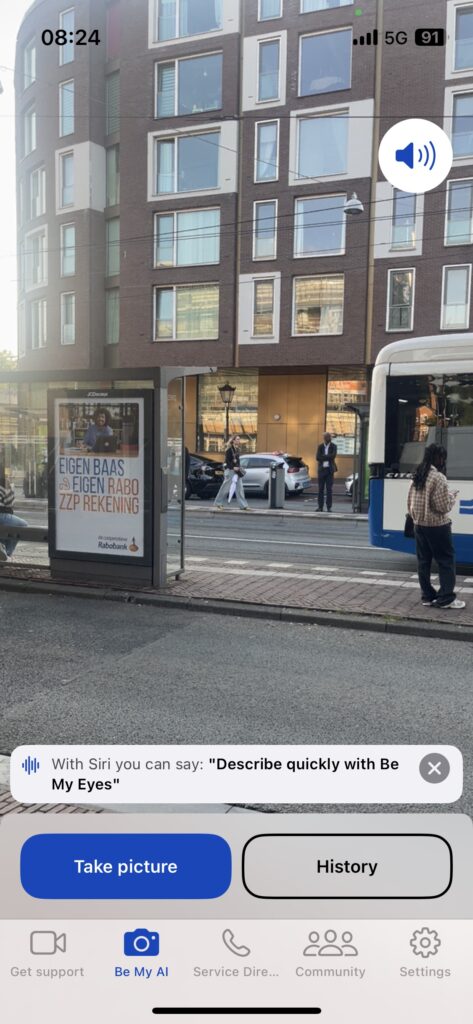
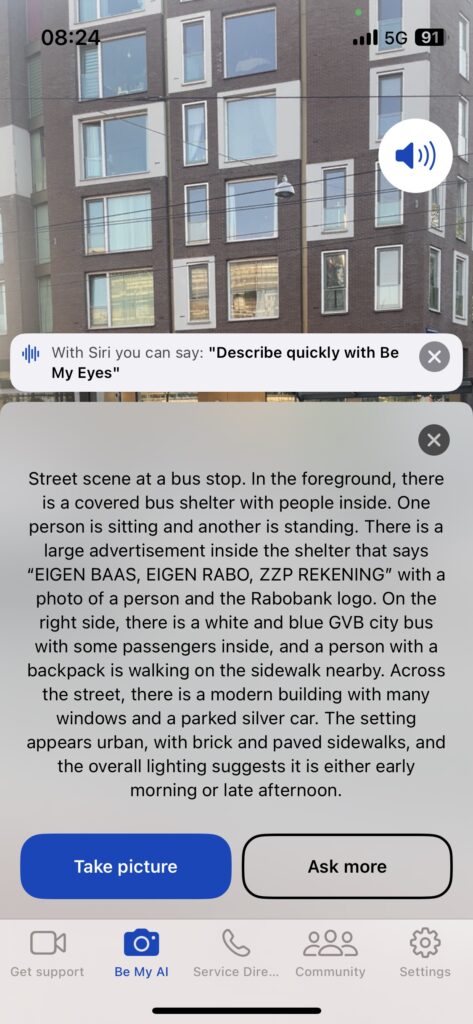
The highlight from this first VoiceOver mode exercise is that technology can be powerful, if usability in practice is clear. Specifically, having VoiceOver mode is a great add-on from Apple, but if it isn’t useful in practice, then it isn’t very valuable. touchscreen devices are a nightmare for blind people, as VoiceOver mode is unclear, resulting in inefficiency and lots of frustration. Even after having tried out VoiceOver mode for a morning, I don’t think I fully grasp how extremely frustrating it is to use touchscreen smartphones being blind every day. I use my smartphone at least 20-50 times per day to quickly check a Whatsapp message, look up opening hours of a cafe, order items, look up my itinerary, look for interesting museums, book a trip and more. It’s hard to wrap my head around doing all of this with VoiceOver mode, given that I wasn’t able to send a Whatsapp message or use Google Maps for my exercise.
B. Navigating from A to B: when left alone, “tell me what is near me”
The blind man that I observed offered me his old cane when I told him I needed to exercise immersive empathy. I considered various options and then decided to try to get on the public transport and ask someone for help. I felt extremely awkward and anxious upfront, and dreaded the idea of being a burden to those around me having to ask them for help. But eventually I gave myself a kick in the butt to execute my plan. I put on my sunglasses and closed my eyes waiting on the bus, being on the bus, and getting off the bus.
This is me with the blind man’s old cane:
During the exercise, my heart was filled with warmth when people around me offered their help getting me safely on and off the bus, and the bus driver was considerate in letting me sit down before taking off. But when I got off, nobody else got off, and I was left all alone at a busy road. I needed to stop the exercise and open my eyes for my own safety. This was my aha-moment: I realised that if you’re blind, don’t have proper navigation, and there is nobody else around you to help out, you could easily be stuck not knowing which direction to go to. It reminds me of this quote from Anneke and Ihab:
“What do I see in front of me. I want a tool that tells me accurately what is around me, not within 10-20 meters, but much nearer.” – Anneke & Ihab
This is exactly what I thought when I had gotten off the bus and was left by myself. I felt incredibly helpless and in danger of being hit by a car. It’s a very different experience having someone who holds your arm, vs walking alone.
C. Social norms: being very self-conscious, not wanting to make a mess or be a burden
Anneke had mentioned several times during the interview how she was self-conscious of being in social settings being blind. For example, she mentioned she preferred a cane over a dog, as she would draw less attention and nuisance walking into a cafe with a cane that she can then fold rather than with a dog that takes extra space. Or how she would decline a pastry with external colleagues who weren’t aware that she was blind. I wanted to experience this for myself. I ended up having a tea in a cafe. Here is what happened:
As the tea wasn’t brought to me, I started my exercise when I had picked up the tea and sat down. I felt extremely self-aware and stressed, not wanting to spill my tea and cause chaos. If I had been hungry, I would have given preference to a dish that would be easy to consume like soup, over something like a sandwich. The highlight, or actually the lowlight, is that social context heavily influenced my behaviour in light of the risk to mess up.
Reflections on Immersive Empathy: feeling extremely humbled having eyesight + a great exercise to engrain previous insights
This immersive empathy exercise has further drawn me into the world of blind people and I’m amazed with my insights. The physical and social obstacles being blind are plentiful: Technology can be empowering but frustrating at the same time, one feels extremely helpless if help is not around and the setting is unfamiliar, and socially, feeling like a burden or stressed about making a mess spilling tea or eating in a way that is socially inappropriate is constantly top of mind when out and about. Thanks to this assignment, I have become more considerate about any potential solution I might create in the future. Besides, the exercise has humbled me further: the ease and efficiency with which people with normal eyesight get to live their life is in stark contract with the burdens that blind people face constantly . Last, thanks to this exercise I now understand the importance of getting into the skin of the target group, as it really helps engrain previous insights and understanding the opportunities and constraints for creating a solution later on.
Lesson 4 Generating Insights
Share one to three insight statements from Step 3 (Craft)
1. Navigation: Independence breaks at the transfer
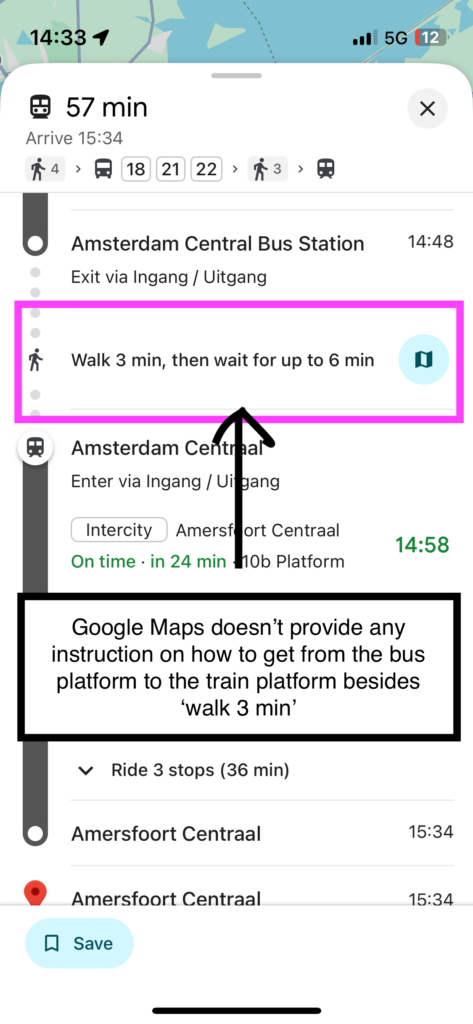
Final Insight:
Blind travelers can navigate independently, but it’s at the ‘handover points’ (transfer between transport modes and indoor building way finding) where current technology and tools fail to ‘pass the baton’.
Draft Variations:
- Transfers, glitches and obstacles (no Wifi, overpass, roadwork signs) decide the extent to which one feels independent.
- The journey is fine, but the station swallows autonomy.
- Navigation apps don’t cater fully for navigation from A to B for the blind.
- Independence needs a baton pass when navigating indoors.
Proof Points:
- Interview: “I want a tool that tells me what’s around me, not within 10–20 meters, but much nearer.”
- Observation: the blind man is perfectly capable of finding his way from his home to the tram station, and from the tram stop to university. Yet, the interview revealed: “Google Maps… doesn’t navigate within stations; I always need to ask for help when I switch transport modes.”
- Immersive empathy exercise getting on the bus blindfolded: the challenge wasn’t to get on and off the bus, but the lack of help from humans or tech to find my way once off the bus.
2. Technology: Tools built with the blind at the center unlock real freedom
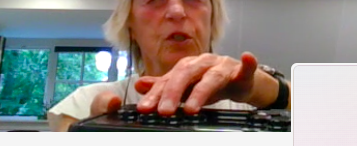
Final Insight:
For blind people, technology is indispensable, but it only empowers when built with them at the center, not as an afterthought.
Draft Variations:
- Blind people depend on technology, but accessibility features aren’t enough
- Accessible ≠ usable: only purpose-built tools empower blind users.
- Using technology is unthinkable for blind people, but is useful only when it is catered to blind people
Proof Points:
The negative:
- Empathy test: VoiceOver conclusions -﹥ inefficient, unclear, frustrating.
- “Touchscreen devices are a nightmare for blind people” (Anneke)
- Ihab uses iPhone with VoiceOver easily although he admits it takes a long time
The positive:
- “Braille display + screen reader let me work effectively.” (Anneke)
- There are many accessibility features for the blind (VoiceOver, Be My Eyes, AI apps, Google Maps, etc.).
- Tools designed specifically for the blind (e.g. braille display, braille reading rule) are much more effective.
3. Social norms: practical feels frowned upon in public
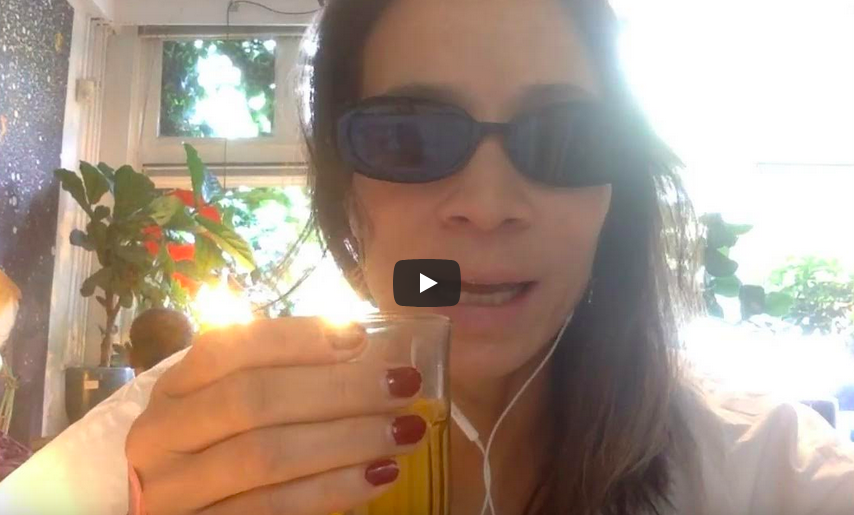
Final insight:
For blind people, the hardest part of being in public is managing the tension between doing what is practical and meeting social expectations
Draft variations:
- Social expectations don’t allow blind people to fully be themselves when in public
- Every sip and bite is also a negotiation with norms
- Practical choices like eating with hands are easiest, but in public they feel socially risky
- The audience, not the activity, makes public life exhausting
Proof points:
- Interview: “I’ll eat the pastry with my hands instead of with cutlery, it’s less messy, but I still feel watched.” (Anneke)
- Empathy test: if I had taken a sandwich, I would have chosen the one that would be easiest to eat to not cause a mess
- Observation: Ihab eats omelet sandwich with hands.
- Empathy test: stressed about spilling tea, felt very self-conscious.
What was surprising, challenging, or easy about the process of crafting insights?
1. Process & Time Investment
- I noticed it took a long time to investigate all my notes, make sense of them, and draw insights from my observation, interview, and empathy tests.
- Iterating on insights was challenging but satisfying once I got to a final version that was memorable, inspiring, and informative!
2. Tools & Support
- Using generative AI (ChatGPT) helped me sharpen my insights: I drafted first versions myself, then asked for help to make them crisp.
- I worked alone this time, but I realized that having a sparring partner would have made the process richer and more efficient.
3. Confidence & Validation
- I wasn’t always sure whether my conclusions made sense. Next time I might need more datapoints to validate my insights.
4. Interviewing Skills
- I need to listen more actively during interviews.
- In hindsight, I could have probed further on specific points, asked for opinions, or simply gotten more out of it by being more present and attentive.
5. Observation Skills
- There is a lot to notice during observation. I want to train myself to really watch the details rather than take what I see for granted.
- Next time I will take more notes so I don’t have to rely mostly on memory.
Bring your insight(s) to life.
